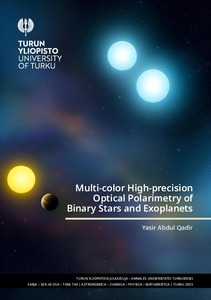Multi-color high-precision optical polarimetry of binary stars and exoplanets
Qadir, Yasir Abdul (2025-12-05)
Multi-color high-precision optical polarimetry of binary stars and exoplanets
Qadir, Yasir Abdul
(05.12.2025)
Turun yliopisto
Julkaisun pysyvä osoite on:
https://urn.fi/URN:ISBN:978-952-02-0433-4
https://urn.fi/URN:ISBN:978-952-02-0433-4
Kuvaus
ei tietoa saavutettavuudesta
Tiivistelmä
This dissertation presents a comprehensive study of multi-wavelength optical polarimetry applied to stellar systems exhibiting variable intrinsic polarization, with a focus on close binary stars and exoplanets. Using high-precision broadband polarimetry with the DiPol-2 instrument on the remotely controlled T60 telescope, we have measured polarization variations with the phase of the orbital period in three O+O binary systems (AO Cassiopeiae (AO Cas), DH Cephei (DH Cep), and HD 165052) and the exoplanet Upsilon Andromedae b ( And b). For two binary systems, DH Cep and HD 165052, phase-locked small-amplitude polarization variability has been detected and analyzed for the very frst time.
For the binary systems, we derived orbital parameters through Fourier analysis of polarization variability, obtaining inclinations and orientations of the orbital planes. Our analysis revealed symmetric distributions of scattering material consistent with Thomson scattering in circumstellar environments. We estimated interstellar polarization contributions through observations of feld stars, revealing uniform dust distributions in the young open stellar cluster NGC 7380 (DH Cep), but strong non-uniformity in cluster NGC 6530 (HD 165052).
For the exoplanet And b, we detected weak periodic signals at half the orbital period but faced challenges in orbital and physical parameters extraction due to very small amplitude of periodic variations and low signal-to-noise. Our Rayleigh-Lambert modeling yielded tentative estimates of planetary orbital parameters and ge¬ometric albedo but with large uncertainties, demonstrating diffculties in exoplanet polarimetry which requires accuracy much better than 10−5.
This work demonstrates polarimetry’s unique ability to probe orbital geometries and scattering environments in stellar systems, while establishing the current limitations for exoplanet characterization. The research advances our understanding of binary star dynamics and circumstellar environments while outlining pathways for future high-sensitivity polarimetric studies.
For the binary systems, we derived orbital parameters through Fourier analysis of polarization variability, obtaining inclinations and orientations of the orbital planes. Our analysis revealed symmetric distributions of scattering material consistent with Thomson scattering in circumstellar environments. We estimated interstellar polarization contributions through observations of feld stars, revealing uniform dust distributions in the young open stellar cluster NGC 7380 (DH Cep), but strong non-uniformity in cluster NGC 6530 (HD 165052).
For the exoplanet And b, we detected weak periodic signals at half the orbital period but faced challenges in orbital and physical parameters extraction due to very small amplitude of periodic variations and low signal-to-noise. Our Rayleigh-Lambert modeling yielded tentative estimates of planetary orbital parameters and ge¬ometric albedo but with large uncertainties, demonstrating diffculties in exoplanet polarimetry which requires accuracy much better than 10−5.
This work demonstrates polarimetry’s unique ability to probe orbital geometries and scattering environments in stellar systems, while establishing the current limitations for exoplanet characterization. The research advances our understanding of binary star dynamics and circumstellar environments while outlining pathways for future high-sensitivity polarimetric studies.
Kokoelmat
- Väitöskirjat [3031]
